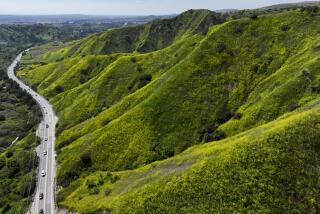A Dry State Can Bring About a Dark State
- Share via
The cautious California water officials who say it is too soon to begin talking about drought are wrong. It is almost too late. It is highly probable that California has entered its first drought of the new century. And despite a long drought a decade ago, we have failed to learn its lessons.
California went through a severe drought between 1987 and 1992. By 1990, most residents found themselves faced with mandatory reductions in water use. Farmers saw surface water supplies curtailed. Ground water dropped to record low levels. Less apparent to most was that the greatest damages fell on California’s natural ecosystems. But in what must be a warning sign for today, the largest economic impact of the last drought was on the supply and demand for electricity.
Between 1987 and 1992, California ratepayers paid an extra $3 billion for electricity that had to be produced with natural gas rather than cleaner and cheaper hydropower plants. Those costs would be much higher today. This shift also added to California’s air pollution problems and increased the state’s emissions of carbon dioxide--the principal gas responsible for the greenhouse effect--by more than 25%.
When California water officials finally get around to acknowledging the drought this time, expect calls for more water storage, for increased transfers from one part of the state to another and for the rollback of modest environmental protections put in place in the past decade.
Certainly, many of California’s traditional water interests are already gearing up to use a new drought to push for the same old solutions: Pour more concrete and build more dams. Yet if there is anything we should have learned from our history with water development over the past 100 years it is that new reservoirs will not prevent the next drought, they will not ease the constraints some water users will feel and they are not in the best interests of the state.
Droughts are inevitable. They are a natural and unavoidable characteristic of California’s water system. But it is not inevitable that droughts must be disasters. California doesn’t have a water supply problem, we have a water use problem. Reducing wasteful use of water and improving water efficiency in every sector would provide a cleaner, cheaper and faster source of supply than any other option.
We also must accept that during severe droughts, we can’t always conduct business as usual. Lawns may have to dry up or even be replaced permanently by plants that don’t suck up vast amounts of water. Farmers, with enough warning, can (and do) shift crop types and irrigation methods. Prices for the largest water users should be allowed to rise to encourage more efficient use. And special care must be taken to protect our natural environment.
The reality is that progress already has been made. Large numbers of inefficient toilets--the largest single water user in our homes--have been replaced with efficient models. Highly water-efficient appliances are coming to market. Innovative ground water storage projects have effectively added vast storage capacity to the state’s existing reservoir system, without destroying any more rivers or pouring more concrete. Precision irrigation equipment lets some farmers produce more crop per drop. New water-sharing arrangements between cities and farmers have been put in place. Some water utilities have set rates that reward conservation efforts and penalize excessive use.
Those cities, farmers and water agencies with the foresight to plan and implement these kinds of programs now have the chance to show the rest of us how good water management is done. And it is time for the rest of us to listen and learn.
More to Read
Sign up for Essential California
The most important California stories and recommendations in your inbox every morning.
You may occasionally receive promotional content from the Los Angeles Times.













